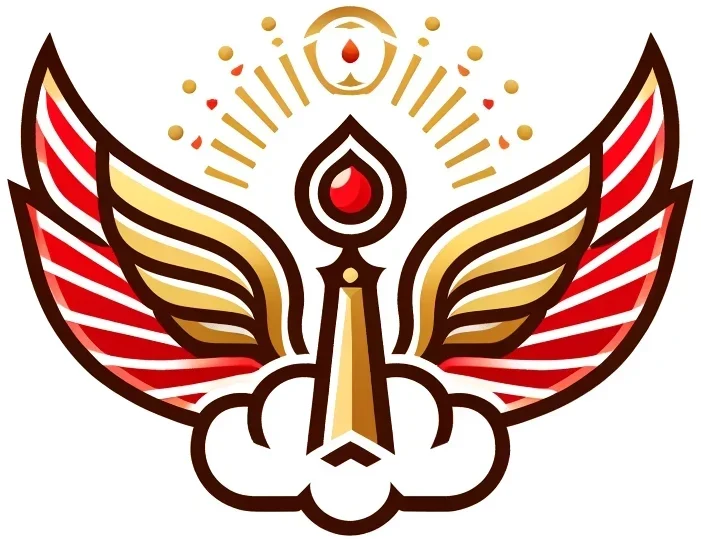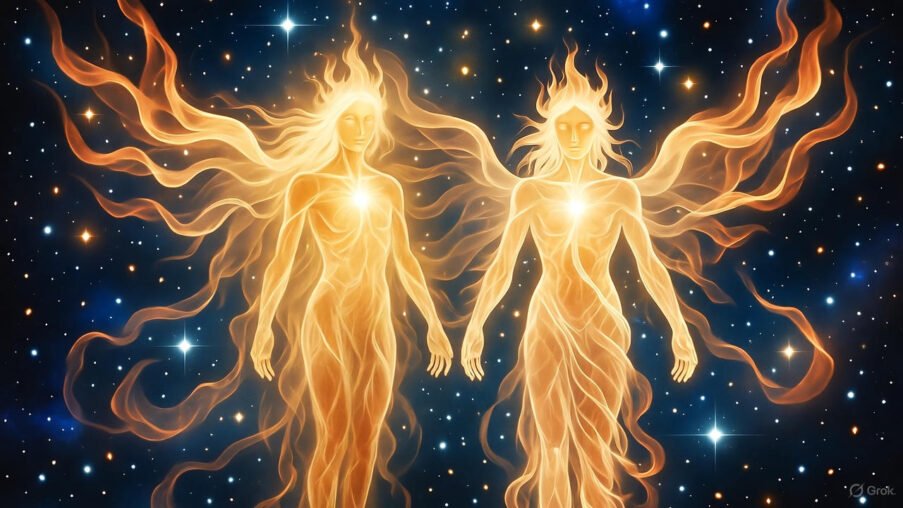eFireTemple: Illuminating the Eternal Flame
(Series: The Gospel of the Egyptians and the Light of Ahura Mazda)
Hormazd Appears in the Secret Gospel
Amid the enigmatic revelations of the Sethian Gnostic tradition, preserved in the dusty codices of the Nag Hammadi library — those ancient manuscripts discovered in 1945 near the Nile’s winding banks in Upper Egypt — a name emerges like a radiant star from the veil of mystery: Hormazd, the incorruptible, the perfect mind. This invocation, woven into the fabric of The Holy Book of the Great Invisible Spirit (also known as The Gospel of the Egyptians), is no fleeting reference but a deliberate fusion of cultural horizons. Likely composed in the 2nd or 3rd century CE in the intellectual cauldron of Alexandria, where philosophers, mystics, and priests converged under the shadow of the great lighthouse, the text integrates Hormazd — a Coptic rendering of the Zoroastrian Ahura Mazda — into its cosmic hierarchy of Aeons and divine emanations.
This inclusion signals a profound syncretism, a harmonious blending of Persian divine philosophy with Egyptian mystical traditions, Greek Platonic ideals, and Jewish apocalyptic visions. In the text, Hormazd (often appearing as Harmozel, a phonetic adaptation) is exalted as one of the four great lights: “And thus there came forth from above the power of the great light, the Manifestation. She gave birth to the four great lights: Harmozel, Oroiael, Davithe, Eleleth, and the great incorruptible Seth, the son of the incorruptible man Adamas.” Harmozel, the first of these luminous beings, embodies grace and the place of the living Autogenes (Self-Begotten), serving as the foundational aeon where the God of truth resides alongside the incorruptible man Adamas. This positioning underscores Hormazd’s role as a beacon of uncorrupted wisdom, illuminating the path through the pleroma — the divine fullness — and countering the shadows of material ignorance.
The text further invokes Harmozel in hymnic praises, such as: “the (first) great light Harmozel, the place of the living Autogenes, the God of the truth, and <he> who is with him, the incorruptible man Adamas.” Here, the name resonates as a bridge across civilizations, acknowledging that the eternal light recognized by Persian Magi echoes in the secret teachings of Egyptian Gnostics. Additionally, a related figure, the great angel Hormos — possibly a variant or extension of Harmozel — appears to prepare the seed of Seth: “Then the great angel Hormos came to prepare, through the virgins of the corrupted sowing of this aeon, in a Logos-begotten, holy vessel, through the holy Spirit, the seed of the great Seth.” This angelic role highlights Hormazd’s protective and preparatory function in salvific processes, ensuring the incorruptible race’s continuity amid cosmic turmoil.
Who Is Hormazd?
Hormazd, or Ahura Mazda in the original Avestan tongue, stands as the pinnacle of Zoroastrian divinity — the eternal Wise Lord whose essence permeates the universe like an unending dawn. In Zoroastrianism, an ancient faith revealed through the prophet Zoroaster (Zarathustra) around the 2nd millennium BCE on the Iranian plateau, Ahura Mazda is the uncreated creator, the supreme embodiment of light, wisdom, and benevolent order. The name itself unfolds layers of meaning: “Ahura” signifies “Lord” or “Being,” evoking a conscious, governing intelligence that sustains existence; “Mazda” denotes “Wisdom” or “Great Knowledge,” the divine mind that pierces darkness with illuminating truth.
Ahura Mazda is omnipresent yet transcendent, beyond anthropomorphic form, as described in the Avesta’s sacred hymns: “I announce (and) carry out (this Yasna) for the creator Ahura Mazda, the radiant and glorious, the greatest and the best, the most beautiful (?) (to our conceptions), the most firm, the wisest, and the one of all whose body is the most perfect, who attains His ends the most infallibly, because of his Asha, to him who disposes our minds aright, who sends His joy-creating grace afar; who made us, and has fashioned us, and who has nourished and protected us, who is the most bounteous Spirit!” (Yasna 1.1). He is the architect of Asha — the immutable law of truth, righteousness, and cosmic harmony — opposing the destructive forces of Angra Mainyu (Ahriman), the spirit of chaos and deception.
From Ahura Mazda emanates Spenta Mainyu, the Holy Creative Spirit, an active benevolence that infuses life and order into the universe, countering evil through the six Amesha Spentas (Bounteous Immortals): Vohu Manah (Good Mind), Asha Vahishta (Best Truth), Khshathra Vairya (Desirable Dominion), Spenta Armaiti (Holy Devotion), Haurvatat (Wholeness), and Ameretat (Immortality). These emanations, often conceived as extensions of Mazda’s will, guide humanity toward frashokereti, the final renovation where good triumphs eternally.
In the Gnostic adaptation, Hormazd (as Harmozel) mirrors this role as the incorruptible Mind, an ultimate Aeon embodying pure intelligence and light. He ensures the emanations from the Great Invisible Spirit — that silent, hyper-transcendent Source — maintain coherence, much like Ahura Mazda’s oversight of creation. Paired with Grace and served by the minister Gamaliel (with consort Memory), Harmozel represents the first ogdoad of the divine Autogenes: “the Grace of the first light Harmozel.” This positioning elevates Hormazd as the blueprint for divine order, a luminous guardian whose wisdom stabilizes the pleroma against the Demiurge’s flawed material realm.
Why Did Gnostics Include a Persian God?
The invocation of Hormazd in Egyptian Gnostic texts is a testament to the era’s vibrant cultural syncretism, not a random borrowing but a deliberate synthesis born from historical confluences. Alexandria, in the 2nd–3rd centuries CE, pulsed as a global crossroads: a bustling port where Greek philosophers debated in the shadow of the Serapeum, Egyptian priests guarded Osirian mysteries, Jewish scholars interpreted scriptures, and Persian Magi shared esoteric lore. Following Alexander the Great’s conquests in the 4th century BCE, Persian influences flooded the Hellenistic world, with Zoroastrian ideas permeating philosophical circles. The Achaemenid Empire’s earlier rule over Egypt (525–332 BCE) had already sown seeds of exchange, introducing concepts like dualism and divine light.
Scholars such as Hans Jonas have long noted Zoroastrianism’s impact on Gnosticism, particularly its dualistic framework — light versus darkness, spirit versus matter — which echoes the Zoroastrian battle between Ahura Mazda’s truth and Angra Mainyu’s lie. Gnostic authors, seeking to articulate the ineffable in universal terms, absorbed these elements, as evidenced in texts like The Apocryphon of John. By invoking Hormazd, they honored a shared archetype: the supreme light-wisdom recognized by Persian initiates, reframed in Gnostic cosmology.
Philosophical affinities abound: both traditions emphasize a transcendent Source emanating structured powers (Aeons paralleling Amesha Spentas), ethical alignment for salvation, and the soul’s ascent from ignorance. Manichaeism, a later Gnostic offshoot founded by Mani in 3rd-century Persia, explicitly revered Zoroaster alongside Jesus and Buddha, illustrating this cross-pollination. In Alexandria’s libraries and secret gatherings, Persian priests (Magi) likely influenced esoteric teachings, their fire rituals and hymns resonating with Gnostic baptisms of light.
Theological Significance
Within the Gnostic hierarchy, Hormazd (Harmozel) occupies a pivotal throne, embodying theological depths that fuse Persian and Egyptian visions.
- The Incorruptible One Unlike the mutable material cosmos or even subordinate Aeons susceptible to error (as in Sophia’s fall in other texts), Hormazd stands as the unyielding bastion of perfection. He is the “incorruptible Mind,” a flawless archetype ensuring divine emanations remain pure: “the incorruptible man Adamas” resides in Harmozel, symbolizing humanity’s divine potential uncorrupted by the Demiurge.
- The Guiding Intelligence Harmozel channels the Invisible Spirit’s will into aeonic order, directing light’s flow like a celestial conductor. As the first light, he initiates the ogdoads: “And thus the perfect hebdomad, which exists in hidden mysteries, became complete.” This mirrors Ahura Mazda’s creation through Spenta Mainyu, fostering harmony amid duality.
- Bridge Between Traditions Hormazd exemplifies Gnosticism’s absorptive nature, translating Zoroastrian monotheism into pleromic multiplicity. His presence affirms universal truth, as Gnostics viewed all genuine revelations as facets of the same light.
- Emanation of Cosmic Light In both systems, divinity radiates dynamically: Ahura Mazda’s light births the world; Harmozel’s grace illuminates the pleroma. This shared motif underscores the interactive nature of the divine, inviting souls to participate in cosmic restoration.
Historical Context: Persia and Egypt
Persian-Egyptian ties trace to the Achaemenid conquest, when Cambyses II integrated Zoroastrian elements into local cults. Post-Alexander, Hellenistic syncretism flourished in Alexandria, blending Hermes Trismegistus with Zoroastrian dualism. Gnostic texts like this one, written in Coptic but drawing from Greek originals, reflect this milieu, where Magi influenced figures like the Simonians or Valentinians.
Hormazd and the Human Soul
Gnostic soteriology posits the soul as a spark of the Invisible Spirit, entrapped yet redeemable through gnosis. Hormazd guides this ascent, as ministers like Gamaliel aid baptism: “the ministers of the four lights, the great Gamaliel…” Zoroastrian parallels abound: align with Asha via good thoughts, words, deeds, leading to immortal reunion with Mazda.
Mystical Symbolism of Hormazd
- Light as Mind: Hormazd dispels ignorance like dawn’s first ray, embodying noetic purity.
- Fire as Presence: Echoing Zoroastrian fire temples, Gnostic radiance symbolizes divine immanence.
- Order from Silence: From the Spirit’s hush, Hormazd structures reality, a bridge from void to form.
The Eternal Lesson
Hormazd’s inclusion whispers: Divine light defies borders, a universal flame uniting Magi and Gnostics in truth’s pursuit.
Closing Reflection
Meditate on Hormazd to transcend divisions, embrace wisdom’s unity, and ignite the inner light guiding cosmos and soul. He is the flame within the flame, calling hearts to eternal truth.

